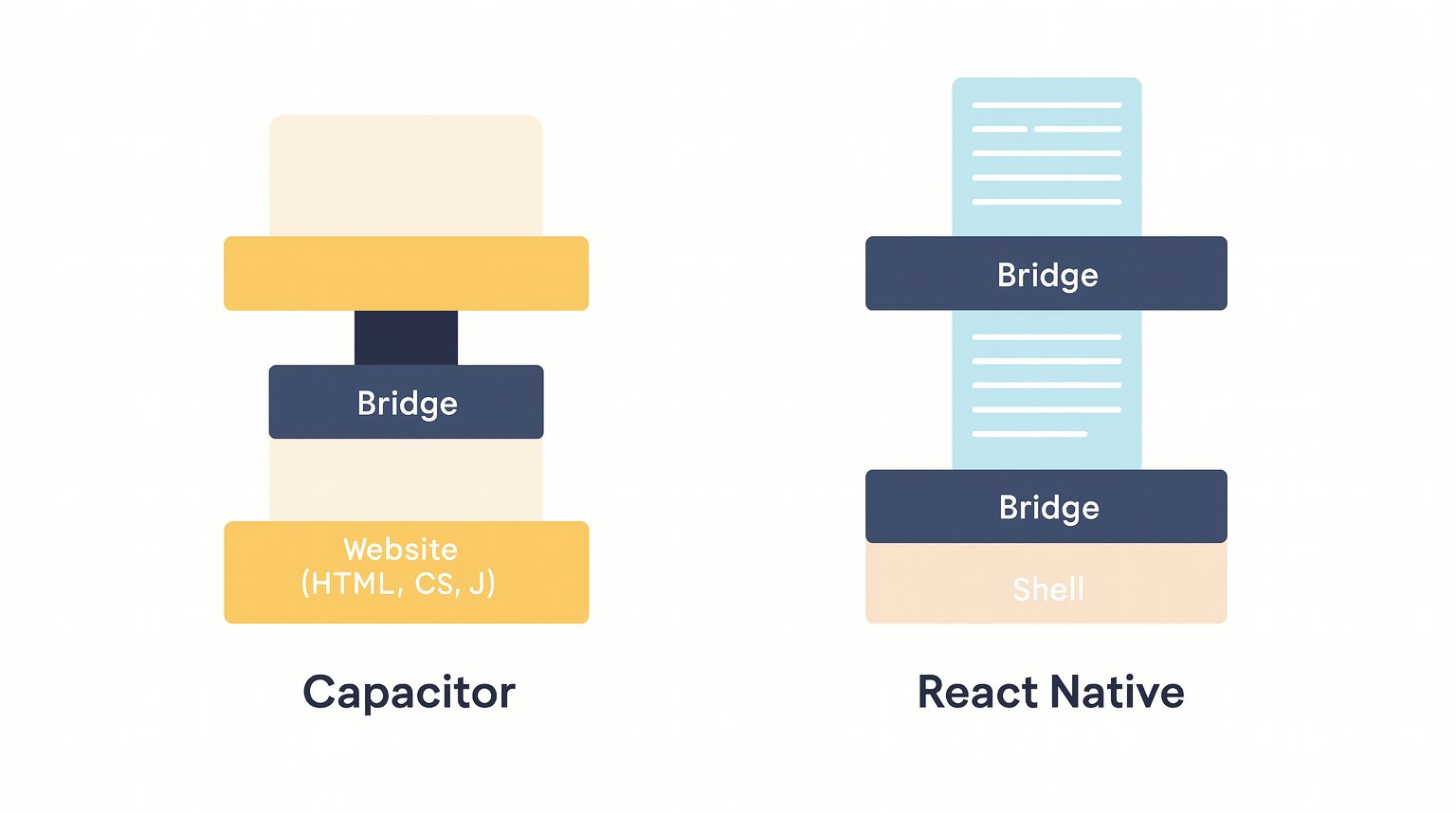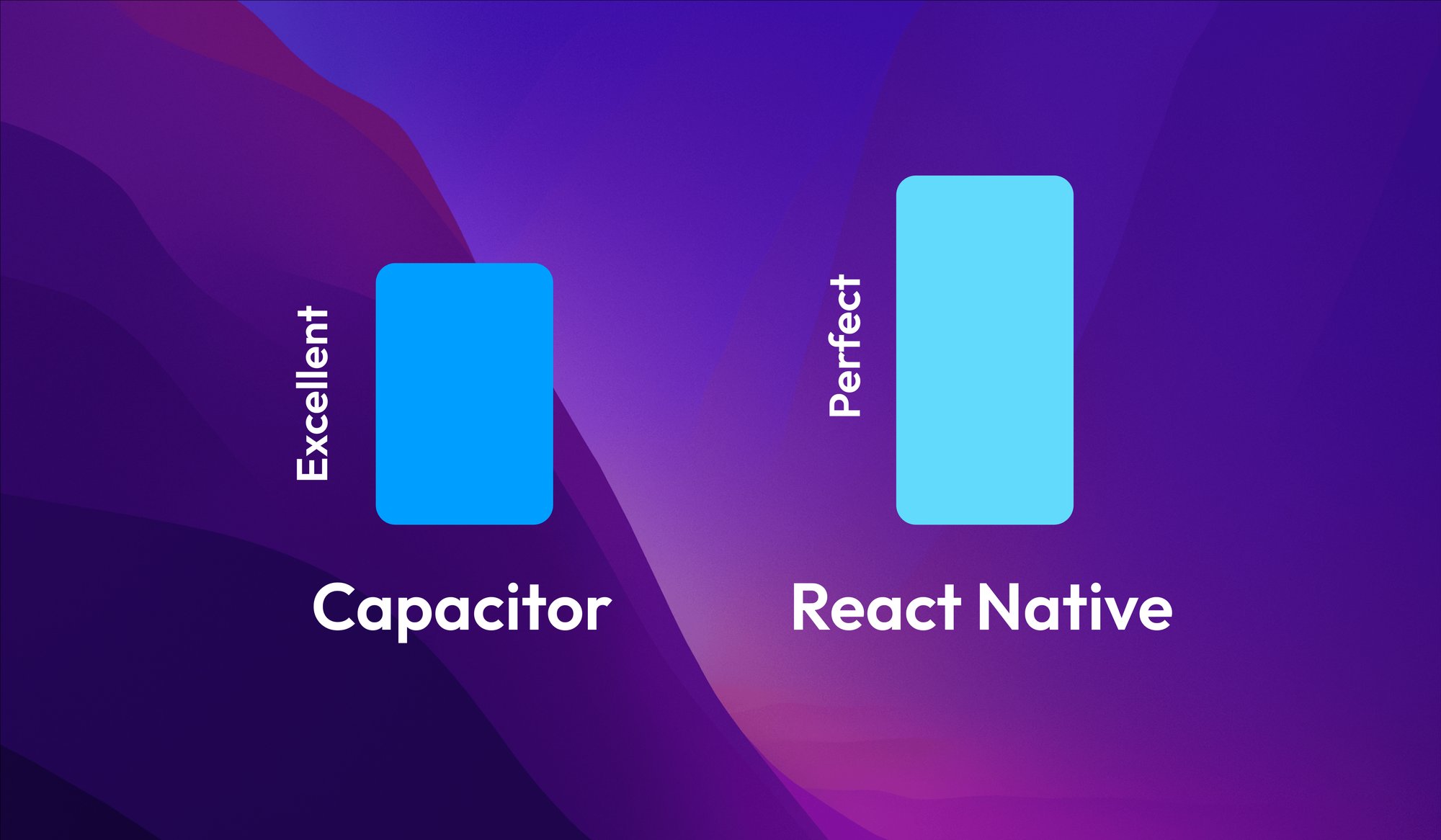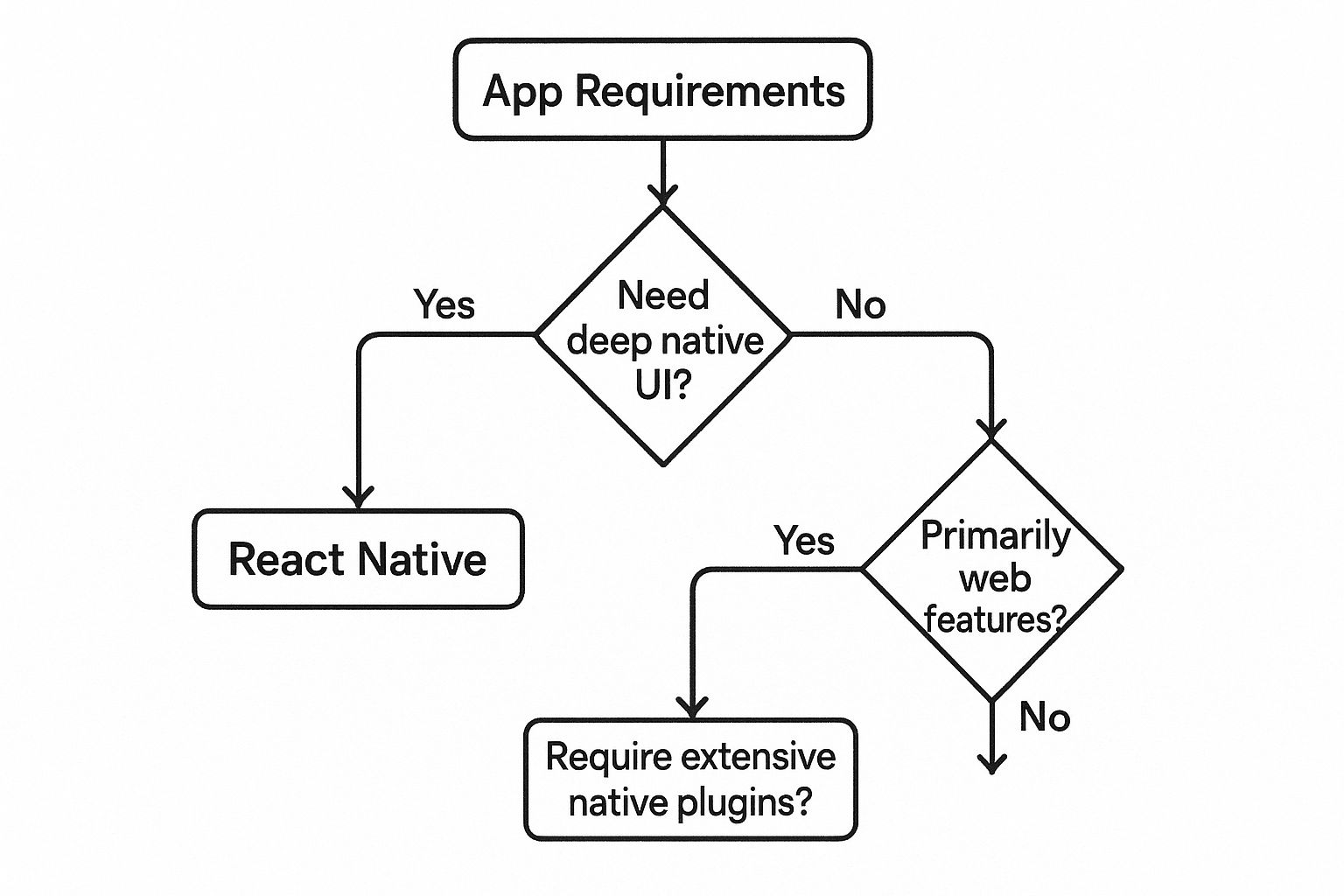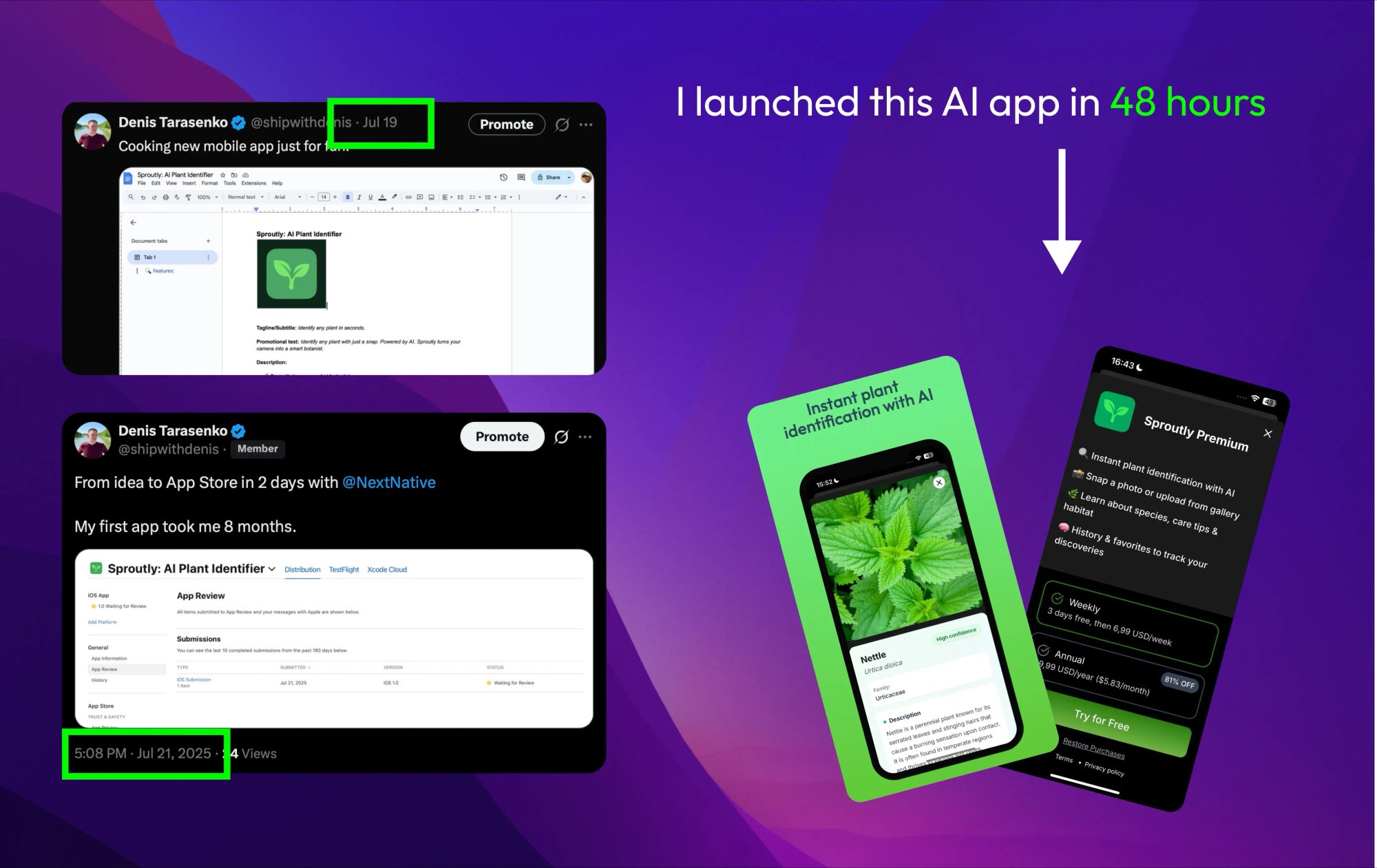Capacitor vs React Native (2025): Which Is Better for Your App?
Updated: October 4, 2025

If you already have a web app, Capacitor gets you into the App Store and Google Play in days.
Using Next.js? Here’s the fastest path: convert your Next.js app to iOS & Android step-by-step.
If you’re building from scratch and want that perfect native feel, React Native might be the better choice.
I’ve built with both, so here’s the real breakdown of speed, cost, and developer experience.
So, the real question is: what matters more to you?
Maximizing code reuse from an existing web project, or achieving that pure native feel?
Your answer will point you in the right direction.
Choosing your mobile development path#
If you’re deciding between Capacitor and React Native, you’re at an important crossroads. This choice will affect how your app performs, how it feels to users, and how your team works every day. My goal is to make it clear so you can choose with confidence.
Capacitor, the successor to Cordova, is a smart bridge that lets your web project run as a native mobile app. Think of it as a powerful container for your web code.
React Native, built by Meta, takes a different approach. It uses the React library to build real native apps from scratch. This difference in design is the foundation for all the pros and cons you’ll see next.
For a broader look at this space, our guide on how to build cross-platform mobile apps can give you some extra context.
Market adoption and popularity#
React Native has been one of the most popular tools for cross-platform development since it came out in 2015.
In 2025, surveys show its market share is anywhere from 8.43% to 42%. Big companies like Instagram and Walmart use it, so it’s clearly a strong choice.
Capacitor is in a different category and isn’t trying to be the most popular.
Its market share is under 5%, which makes sense because it’s mainly for teams who want to turn web projects into mobile apps without rebuilding everything.
You can dig into more stats about these and other top cross-platform frameworks in 2025.
Key takeaway: React Native is the popular choice with a big community. Capacitor is great for teams that want to use their web skills and code as much as possible.
Capacitor vs React Native: Quick overview#
Before we dive into details, here’s a simple table that shows the main differences between the two.
Attribute | Capacitor | React Native |
|---|---|---|
Core Philosophy | Web-First (wrap a web app) | Native-First (render native UI) |
UI Rendering | HTML/CSS in a WebView | Native UI Components |
Learning Curve | Low for web developers | Moderate; requires React knowledge |
Primary Use Case | Porting web apps to mobile | High-performance, native-feel apps |
Code Reusability | Excellent (Web, iOS, Android) | Good (iOS, Android) |
Think of this as your quick guide. Now, let’s look at what these differences mean for your project.
Understanding how they’re built#

To truly compare Capacitor vs React Native, you need to look beyond the marketing and see how each one works inside.
They work in very different ways, and that shapes everything: from your app’s performance to what it’s like to code with them each day.
Capacitor is “web-first.” Think of it as a modern, supercharged Trojan horse for your web app.
You build your app with the HTML, CSS, and JavaScript you already know.
Capacitor then puts that code inside a native WebView, basically, a browser window inside your mobile app.
This lets your web code use native features like the camera, GPS, or file system.
The best part is how simple it is. If you already have a web app, you’re about 90% ready to have a native mobile app.
The Capacitor WebView model#
In Capacitor, the WebView is the main part, it’s what shows all your web content.
Capacitor adds a light native layer around it, giving you access to device features through easy-to-use plugins. You can keep building in React, Vue, Svelte, or whatever you like, and only use Capacitor when you need something “native.”
Think of your web app as a skilled guitar player. Capacitor is the sound engineer who sets up the microphone (plugin API) so the music can blast through powerful speakers, the mobile device.
The guitarist doesn’t need to learn a new instrument, just how to use the mic.
This setup lets you reuse your code almost completely. One codebase can power your website, PWA, and native apps for iOS and Android.
For teams focused on web tech, Capacitor is more than just another tool, it’s a big boost. It can turn your web developers into mobile developers almost instantly, without making them give up the tools and skills they already know.
This makes it ideal for turning existing web platforms into mobile apps, building content-heavy apps, or launching an MVP as quickly as possible.
The React Native bridge architecture#
React Native, on the other hand, operates on a "learn once, write anywhere" principle, which is a completely different ballgame. It doesn't use a WebView at all. Instead, you write your app's logic in JavaScript and React, and React Native acts as an interpreter, translating your code into genuine, 100% native UI components.
This translation all happens across a special mechanism everyone calls the "bridge." Your JavaScript code lives and runs on its own thread, completely separate from the main native UI thread. When your code says "render a button," it sends a serialized, asynchronous message over the bridge to the native side. The native side receives that message and creates a real, platform-specific UI button.
The result is an app that looks, feels, and performs like it's truly native, because, from the user's perspective, it is. The animations are buttery smooth, scrolling is snappy, and every component conforms to the platform's design language. Your user is touching real iOS and Android components, not a webpage styled to look like them.
This architecture brings a few key advantages to the table:
Native Performance: Since it renders native UI, React Native can handle complex gestures and heavy animations much more gracefully than a WebView ever could.
Authentic UI: Users get the exact experience they expect from their device, which builds trust and feels more polished.
Deep Platform Access: While both have plugins, React Native’s architecture is often a better choice for apps that need deep and continuous access to platform-specific APIs.
The trade-off, of course, is a steeper learning curve and a significant hit to code reuse with the web. You can share some of your business logic, but the entire UI layer is specific to React Native's component ecosystem.
At the end of the day, the Capacitor vs React Native decision often comes down to this core choice: Do you want the universal portability of the web, or the high-fidelity performance of native rendering?
Comparing real-world performance#

This is where the rubber meets the road. All the architectural theory about Capacitor vs React Native comes down to one question: how does the app actually feel in a user's hands? While benchmarks give us numbers, real-world experience is what truly matters.
Most people say React Native wins here because it uses real native UI components. And for some types of apps, that’s definitely true.
If you’re making an app with detailed, real-time charts or a social feed full of complex swipe animations, React Native has the edge. Its native UI thread makes the app feel smooth and responsive, something that’s hard for a WebView-based app to fully match.
But the performance story isn’t that black and white. For most apps, Capacitor’s performance isn’t just “good enough” - it’s excellent.
The modern WebView advantage#
Modern WebViews are far from weak.
After years of competition between browser makers, they now have powerful JavaScript engines and hardware-accelerated CSS animations built in.
This means that for most business apps, online stores, or content-heavy platforms, users may not notice any difference between a well-built Capacitor app and a React Native app.
Scrolling through products or browsing pages will feel just as quick and smooth.
Key insight: Performance isn’t a simple yes or no - it’s a spectrum. The real question isn’t “Which one is faster?” but “When does my app’s complexity actually require native rendering?”
The key is knowing when a WebView might slow down.
If your app does heavy, nonstop calculations on the main thread or makes constant complex changes to the DOM, a Capacitor app might stutter or drop frames.
A skilled web developer can fix many of these issues, but React Native’s multi-threaded design avoids them for UI work from the start.
Startup time and memory use#
The first launch of your app is your chance to impress. In this area, React Native often feels a bit faster because it only needs to load its JavaScript bundle and start the native views.
A Capacitor app has to start its native container, load the WebView, and then load your web app’s HTML, CSS, and JavaScript. This can make the first launch a bit slower, but usually only by milliseconds. You can speed this up a lot with techniques like code-splitting and lazy loading.
Here’s a simple comparison of how they perform in the main areas.
Performance Metric | Capacitor (WebView) | React Native (Native) |
|---|---|---|
Complex Animations | Good, but can stutter under heavy JS load. | Excellent. Animations run on the native UI thread. |
Startup Time | Generally good, but can be a bit slower on a cold start. | Excellent, often has a faster "time-to-interactive." |
Memory Usage | Can be higher due to the overhead of the browser engine. | Usually more memory-efficient for UI. |
Standard UI | Excellent for the vast majority of apps. | Excellent, with a look and feel that's 100% native. |
Memory use is another factor. React Native apps can be lighter because they only load the native components needed for the current screen. Capacitor apps keep the whole browser engine in memory, so their baseline size is naturally a bit bigger.
For any team weighing their options, spending time with different cross-platform app development tools is the best way to get a feel for these trade-offs.
In the end, both frameworks can deliver high-performance apps.
The choice depends on your project.
If your app relies on complex animations and gestures, React Native is the faster route to that smooth feel.
For most other cases, a well-made Capacitor app will give users a great experience while letting your team stay within the web tools they already know.
The developer experience and ecosystem#

Let’s be honest now.
Beyond specs and benchmarks, what really matters is the daily experience of building an app:
How easy is it to work with these tools?
Here’s where we look at the learning curve, available tools, and the community you’ll rely on when you need help.
For web developers, Capacitor feels familiar right away. It’s built to make moving into mobile development as easy as possible.
You keep using the skills you already have (React, Angular, Vue, or anything else) and let Capacitor’s simple CLI handle the native parts.
The learning curve is almost flat.
If you can build a website, you can build a Capacitor app.
React Native asks for a bigger commitment. It still uses JavaScript and React, but in its own way.
You’ll need to learn its special component library, its CSS-like styling (with its own quirks), and its approach to things like navigation.
It takes more effort at the start, but that effort pays off with a strong, native-focused workflow.
Tooling and workflow comparison#
Your tools can make or break your productivity. In the Capacitor vs React Native comparison, both give you great options for building, testing, and fixing bugs, but they work in very different ways.
Capacitor’s workflow is simple and familiar.
Most of the time, you’re just building a web app and debugging in your browser with the tools you already use.
When you need to test a native feature like the camera or GPS, one command runs your app in a simulator or on a real device.
It feels more like web development with extra superpowers than traditional mobile development.
React Native’s tooling is more specialized. Many developers start with Expo, which hides much of the tricky native setup.
Debugging is powerful too, with tools like Flipper that let you see deep inside your running app.
It’s a full ecosystem built specifically for one thing, making great native apps with JavaScript.
Developer insight: It often comes down to mindset. A web developer might say, “Why learn a whole new way to style a button when CSS already works?” A React Native developer might reply, “Why use a web-based button when I can have a native one that feels perfect on the device?”
Plugin availability and community support#
No framework can do everything by itself. Plugins and community support are what turn a good tool into a great one.
Here, React Native’s head start is clear. Backed by Meta for years, it has a huge library of third-party packages for nearly anything you can imagine, from advanced mapping tools to full-featured video editors.
Capacitor’s ecosystem is smaller but growing quickly. It also works with most old Cordova plugins, giving you access to a large library right away.
The official plugins are high quality and well-documented. If you need something very specific, you might have to create a custom native plugin, but Capacitor makes that easier than you’d expect.
A strong ecosystem can save you hundreds of hours, a key factor when choosing from the best cross-platform frameworks.
The job market shows how widely each is used. A quick search on sites like Indeed turns up thousands of React Native roles each year, far more than for Capacitor.
This reflects React Native’s strong presence in the industry, with big names like Facebook, Pinterest, and Shopify using it.
When choosing a framework, it’s worth thinking about the talent pool and your career path.
You can dive deeper into this comparison on Capgo's blog.
In the end, React Native gives you a wide, well-traveled road with solutions for almost any problem you’ll face.
Capacitor offers a leaner, more modern path that lets web developers step into native app development using the tools they already know.
When to choose Capacitor or React Native#
Specs don’t mean much until you match them to your project, team, and goals.
Choosing between Capacitor vs React Native isn’t just a technical decision, it’s a strategic one that will shape how you build apps for years.
This decision tree gives you a quick visual cheat sheet for the big questions you should be asking.

As you can see, the main split happens early on: are you starting from an existing web app, or are you aiming for a deep native feel from the start?
Situations where Capacitor wins#
Capacitor shines when speed and efficiency matter, especially for teams already strong in web development. It’s the perfect bridge for web developers who want to launch mobile apps without starting from scratch.
You’ll probably want to choose Capacitor if your situation looks like this:
You already have a great web app: If you’ve put time and money into a solid web app, Capacitor can wrap it for the app stores fast. You can keep your existing code and just add mobile features on top.
Your team lives and breathes web tech: If your team knows HTML, CSS, and frameworks like React, Vue, or Angular, they can start building with Capacitor right away, no steep learning curve.
Time to market is everything: For an MVP, internal tool, or quick proof-of-concept, Capacitor can get you from web project to iOS/Android app in a fraction of the time.
Your app is mostly for displaying content: If you're building a news reader, an e-commerce storefront, or a company portal, a modern WebView is more than powerful enough. You get great performance without the extra complexity.
Here’s the key takeaway: Capacitor opens the door for web developers to build mobile apps, breaking down the old barriers between web and native development.
Scenarios demanding React Native#
React Native is the best choice when your app needs a true native feel and top-notch performance, especially with complex UI. It’s ideal for polished, consumer-facing apps where every detail matters.
You’ll want to choose React Native for these kinds of projects:
A "Pixel-Perfect" native UI is a must: If your app has to look, feel, and animate exactly like it was built with Swift or Kotlin, React Native is the clear winner. By rendering real native UI components, it nails the platform-specific conventions, gestures, and animations.
Your app has complex animations or gestures: For anything highly interactive. Think photo editors, data visualization dashboards, or even simple games. In those cases, React Native’s architecture shines. It runs the UI on a separate native thread, keeping everything smooth and responsive.
Deep native API integration is core to your app: If your app relies on heavy, constant use of hardware like Bluetooth, advanced background tasks, or AR, React Native offers a more direct, reliable path.
You're building a big, consumer-facing product: For ambitious, long-term apps with large audiences, React Native’s ecosystem, talent pool, and Meta’s backing provide stability and room to grow.
Situational recommendations#
So, how do you make the final call? The right framework depends entirely on your specific circumstances. This table breaks down the decision into a simple, head-to-head comparison to guide your choice.
Choose Capacitor If... | Choose React Native If... |
|---|---|
You're porting an existing web app to mobile. | You're building a new mobile app from scratch. |
Your team's expertise is in HTML, CSS, and JavaScript. | Your team has experience with React and wants a native feel. |
Speed to market for an MVP or internal tool is the top priority. | UI performance and native fidelity are non-negotiable product requirements. |
The app is primarily content-driven (e.g., e-commerce, news). | The app involves complex animations, gestures, or heavy computation. |
You want 100% code reuse between your web and mobile platforms. | You need deep, frequent access to native device APIs (e.g., Bluetooth, AR). |
You prefer a minimalist, unopinionated approach to your stack. | You want a large, mature ecosystem with extensive libraries and community support. |
You're building for a broad B2B or enterprise audience. | You're targeting a mass-market, consumer audience where UX polish is critical. |
Ultimately, both are fantastic, powerful tools.
Your job is to pick the right one for your project.
For a wider view, checking out other cross-platform app development tools can give you even more context to make a smart, informed decision that perfectly aligns with your needs.
Alright, let's wrap this up.
When you're standing at the crossroads of Capacitor and React Native, the choice isn't about finding a one-size-fits-all "winner."
It's about making a smart, strategic decision that fits your team, your product, and where you see it going.
Think of it this way: If your main mission is to get a web app onto mobile devices fast, reusing as much code as possible, then Capacitor is your most direct route.
It brilliantly turns your team's web development skills into a massive advantage, letting you launch quickly with a single, unified codebase. It’s a pragmatic and powerful choice.
But, if your vision is a mobile app that feels absolutely native, with fluid animations and the kind of polish you’d expect from something built in Swift or Kotlin, then React Native is the undisputed heavyweight champion.
It’s the go-to when you need top-tier performance for demanding UIs and can't compromise on that native feel.
A quick sanity check before you decide#
To make sure you're on the right track, run through these final questions. Be honest with your answers; they'll point you in the right direction.
Your team's DNA: Is your team full of web developers who live and breathe frameworks like React, Vue, or Angular? Or is the team grounded in React and ready to dive into a more native-focused world?
The project's origin: Are you porting an existing web app to mobile? Or are you starting from a blank slate, building a mobile-first experience from scratch?
Performance demands: Will your app mostly show content, like articles and user profiles? Or will it feature complex animations, real-time charts, or intense background tasks?
The long game: Is the dream a single codebase for both web and mobile? Or can you foresee a future where you’ll need to write custom native code for deep, platform-specific features?
The bottom line is this: Play to your strengths. Capacitor lets you build on what you already know as a web developer. React Native gives you a clear path to a high-performance native experience, built with React.
Getting this choice right from the start makes all the difference. By taking a moment to think through these points, you can move forward confidently, knowing you’ve picked the framework that won't just get your app built, but will help it succeed for years to come.
Frequently asked questions#
Can I use native UI components with Capacitor?#
Not like React Native. Capacitor runs in a WebView, so the UI is HTML/CSS/JS. You can add native elements via custom plugins, but only for specific features.
Is React Native harder to learn than Capacitor?#
For web devs, yes. Capacitor feels like building a website. React Native has its own components, styling, and navigation - steeper learning curve, but more native feel.
How does App Store approval differ between them?#
Apple and Google don’t care which you use. A quality app passes. Just don’t ship a lazy “website wrapper.”
If you're curious about where these two fit into the bigger picture, checking out other cross-platform app development tools can provide some valuable context.
It's all about finding that sweet spot between your team's skills and your long-term goals.
Ready to build powerful native apps without leaving your web workflow?
NextNative provides production-ready boilerplates combining Next.js and Capacitor, saving you weeks of setup and letting you focus on building features.
Check out our toolkit at NextNative to get started.
